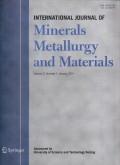- 钛学术文献服务平台 \
- 学术期刊 \
- 工业技术期刊 \
- 冶金工业期刊 \
- 矿物冶金与材料学报期刊 \
Simulation on scrap melting behavior and carbon diffusion under natural convection
Simulation on scrap melting behavior and carbon diffusion under natural convection
基本信息来源于合作网站,原文需代理用户跳转至来源网站获取
摘要:
A 3D model applying temperature- and carbon concentration- dependent material properties was developed to describe the scrap melting behavior and carbon diffusion under natural convection. Simulated results agreed reasonably well with experimental ones. Scrap melt-ing was subdivided into four stages: formation of a solidified layer, rapid melting of the solidified layer, carburization, and carburization + nor-mal melting. The carburization stage could not be ignored at low temperature because the carburization time for the sample investigated was 214 s at 1573 K compared to 12 s at 1723 K. The thickness of the boundary layer with significant concentration difference at 1573 K increased from 130 μm at 5 s to 140 μm at 60 s. The maximum velocity caused by natural convection decreased from 0.029 m·s?1 at 5 s to 0.009 m·s?1 at 634 s because the differences in temperature and density between the molten metal and scrap decreased with time.

推荐文章
Diffusion in garnet: a review
High temperature and high pressure
Diffusion
Garnet
Point defects
Limestone mechanical deformation behavior and failure mechanisms: a review
Mechanical deformation
Brittle fracture
Ductility failure
Strength criterion
Microaerobic iron oxidation and carbon assimilation and associated microbial community in paddy soil
Paddy soil
Microaerobic Fe(Ⅱ)-oxidation
CO2 assimilation
SIP
内容分析
关键词云
关键词热度
相关文献总数
(/次)
(/年)
引文网络
引文网络
二级参考文献 (19)
共引文献 (0)
参考文献 (16)
节点文献
引证文献 (0)
同被引文献 (0)
二级引证文献 (0)
1953(1)
- 参考文献(0)
- 二级参考文献(1)
1966(1)
- 参考文献(1)
- 二级参考文献(0)
1967(1)
- 参考文献(1)
- 二级参考文献(0)
1969(1)
- 参考文献(1)
- 二级参考文献(0)
1970(1)
- 参考文献(1)
- 二级参考文献(0)
1972(1)
- 参考文献(1)
- 二级参考文献(0)
1973(1)
- 参考文献(1)
- 二级参考文献(0)
1974(1)
- 参考文献(1)
- 二级参考文献(0)
1989(1)
- 参考文献(1)
- 二级参考文献(0)
1990(1)
- 参考文献(1)
- 二级参考文献(0)
1992(1)
- 参考文献(0)
- 二级参考文献(1)
1993(1)
- 参考文献(0)
- 二级参考文献(1)
1994(1)
- 参考文献(0)
- 二级参考文献(1)
1995(3)
- 参考文献(1)
- 二级参考文献(2)
1998(1)
- 参考文献(0)
- 二级参考文献(1)
2003(2)
- 参考文献(0)
- 二级参考文献(2)
2004(1)
- 参考文献(0)
- 二级参考文献(1)
2007(1)
- 参考文献(0)
- 二级参考文献(1)
2008(2)
- 参考文献(0)
- 二级参考文献(2)
2009(1)
- 参考文献(0)
- 二级参考文献(1)
2011(1)
- 参考文献(0)
- 二级参考文献(1)
2012(2)
- 参考文献(1)
- 二级参考文献(1)
2013(1)
- 参考文献(1)
- 二级参考文献(0)
2014(1)
- 参考文献(0)
- 二级参考文献(1)
2015(2)
- 参考文献(0)
- 二级参考文献(2)
2017(1)
- 参考文献(1)
- 二级参考文献(0)
2018(1)
- 参考文献(1)
- 二级参考文献(0)
2019(2)
- 参考文献(2)
- 二级参考文献(0)
2021(0)
- 参考文献(0)
- 二级参考文献(0)
- 引证文献(0)
- 二级引证文献(0)
引文网络交叉学科
相关学者/机构
期刊影响力
矿物冶金与材料学报
主办单位:
北京科技大学
出版周期:
月刊
ISSN:
1674-4799
CN:
11-5787/TF
开本:
出版地:
北京科技大学(北京海淀区学院路30号)
邮发代号:
创刊时间:
语种:
eng
出版文献量(篇)
3119
总下载数(次)
0
总被引数(次)
10994
期刊文献
相关文献
推荐文献
- 期刊分类
- 期刊(年)
- 期刊(期)
- 期刊推荐
一般工业技术
交通运输
军事科技
冶金工业
动力工程
化学工业
原子能技术
大学学报
建筑科学
无线电电子学与电信技术
机械与仪表工业
水利工程
环境科学与安全科学
电工技术
石油与天然气工业
矿业工程
自动化技术与计算机技术
航空航天
轻工业与手工业
金属学与金属工艺
矿物冶金与材料学报2022
矿物冶金与材料学报2021
矿物冶金与材料学报2020
矿物冶金与材料学报2019
矿物冶金与材料学报2018
矿物冶金与材料学报2017
矿物冶金与材料学报2016
矿物冶金与材料学报2015
矿物冶金与材料学报2014
矿物冶金与材料学报2013
矿物冶金与材料学报2012
矿物冶金与材料学报2011
矿物冶金与材料学报2010
矿物冶金与材料学报2009
矿物冶金与材料学报2008
矿物冶金与材料学报2007
矿物冶金与材料学报2006
矿物冶金与材料学报2005
矿物冶金与材料学报2004
矿物冶金与材料学报2003
矿物冶金与材料学报2002
矿物冶金与材料学报2001
矿物冶金与材料学报2000
矿物冶金与材料学报1999
矿物冶金与材料学报2021年第9期
矿物冶金与材料学报2021年第8期
矿物冶金与材料学报2021年第7期
矿物冶金与材料学报2021年第6期
矿物冶金与材料学报2021年第5期
矿物冶金与材料学报2021年第4期
矿物冶金与材料学报2021年第3期
矿物冶金与材料学报2021年第2期
矿物冶金与材料学报2021年第10期
矿物冶金与材料学报2021年第1期

 免费查重
免费查重










